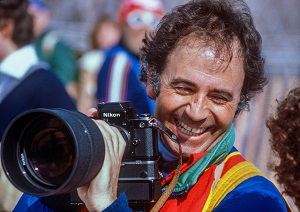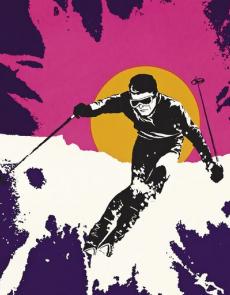SKIING HISTORY
Editor Seth Masia
Managing Editor Greg Ditrinco
Consulting Editor Cindy Hirschfeld
Art Director Edna Baker
Editorial Board
Seth Masia, Chairman
John Allen, Andy Bigford, John Caldwell, Jeremy Davis, Kirby Gilbert, Paul Hooge, Jeff Leich, Bob Soden
Founding Editors
Morten Lund, Glenn Parkinson
To preserve skiing history and to increase awareness of the sport’s heritage
ISHA Founder
Mason Beekley, 1927–2001
ISHA Board of Directors
Rick Moulton, Chairman
Seth Masia, President
Wini Jones, Vice President
Jeff Blumenfeld, Vice President
John McMurtry, Vice President
Bob Soden (Canada), Treasurer
Richard Allen, Skip Beitzel, Michael Calderone, Dick Cutler, Wendolyn Holland, Ken Hugessen (Canada), David Ingemie, Joe Jay Jalbert, Henri Rivers, Charles Sanders, Einar Sunde, Christof Thöny (Austria), Ivan Wagner (Switzerland)
Presidential Circle
Christin Cooper, Billy Kidd, Jean-Claude Killy, Bode Miller, Doug Pfeiffer, Penny Pitou, Nancy Greene Raine
Executive Director
Janet White
janet@skiinghistory.org
Membership Services
Jamie Coleman
(802) 375-1105
jamie@skiinghistory.org
Corporate Sponsorships
Peter Kirkpatrick
(541) 944-3095
peterk10950@gmail.com
Bimonthly journal and official publication of the International Skiing History Association (ISHA)
Partners: U.S. Ski and Snowboard Hall of Fame | Canadian Ski Museum and Hall of Fame
Alf Engen Ski Museum | North American Snowsports Journalists Association | Swiss Academic Ski Club
Skiing History (USPS No. 16-201, ISSN: 23293659) is published bimonthly by the International Skiing History Association, P.O. Box 1064, Manchester Center, VT 05255.
Periodicals postage paid at Manchester Center, VT and at additional mailing offices. Postmaster: Send address changes to ISHA, P.O. Box 1064, Manchester Center, VT 05255
ISHA is a 501(c)(3) public charity. EIN: 06-1347398
Written permission from the editor is required to reproduce, in any manner, the contents of Skiing History, either in full or in part.
Hubert Schriebl: Six Decades of Mountain Photos
The Austrian mountain guide shot four Olympics, four Himalayan expeditions and countless scenes around his Vermont home.
Photo above: “At the downhill, I got frostbite on my nose from pressing the camera too long against my face. Next morning, I wiped the skin away.” [Photo taken by Dick Needham at the 1980 Lake Placid Olympics.]
Hubert Schriebl grew up climbing and skiing in Austria, then apprenticed as a saddle- and harness-maker. He moved to Innsbruck, the nation’s mountaineering hub, in 1955, at age 19. “I worked at the Kohler Sports factory, making leather grips for ski poles and the like,” he says. “I loved skiing the steep Nordkette runs on the north side of town, on the Seegrube lifts.” He became a certified ski and mountain guide, and in 1961 joined a German survey team mapping in the Himalaya. The work entailed photography. It was the first of his four trips to Asia.
“In 1964, while preparing to lead a Dutch expedition to Nepal, I met Emo Henrich in Igls,” Schriebl recalls. In 1961, Henrich had been named director of the new Strat- ton Mountain ski resort in Vermont. Says Schriebl, “He asked what I planned to do when I got back and invited me to Stratton. I had been thinking of guiding out of Lech, but thought I’d try one winter in America.” In late October, Schriebl led the first ascent of 23,000-foot Manaslu North. He arrived in Stratton two months later, on Christmas Eve.
In addition to shooting at Stratton, Schriebl landed choice assignments from SKI and Skiing magazines, Sports Illustrat- ed, Time, Newsweek and Vermont Life. He photographed four Winter Olympics—Innsbruck (1964 and 1976), Lake Placid (1980) and Sarajevo (1984)—and captured mountaineering expeditions in the Arctic, Africa and Mexico. He’s climbed Mont Blanc nine times and climbed Monte Rosa on his 70th birthday. --Seth Masia
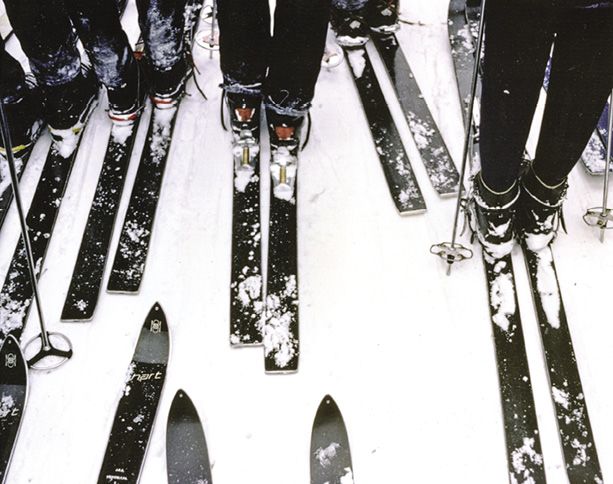
“It was 1965, shortly after I arrived at Stratton. I was amazed at all the complicated equipment, especially the bindings. American skiers had Cubcos, Looks, Markers, all the differ- ent cable bindings, plus Head and Hart skis, and colorful boot brands. All I’d seen in Austria were the local brands, Kneissl and Kästle.”
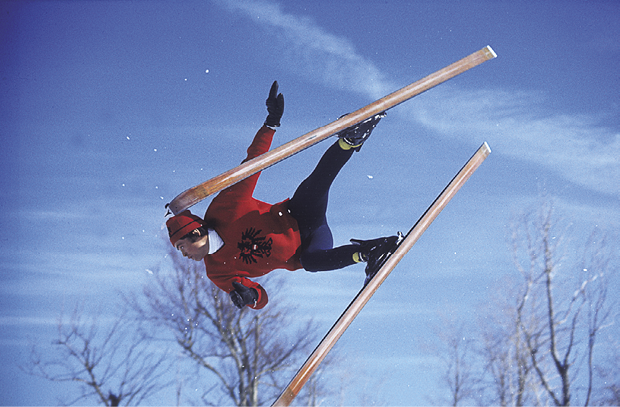
"In 1968, Hermann Goellner came to Stratton and showed us what he could do in the air. One of our instructors, Kasi Lindlebauer, had incredible reflexes and always landed on his feet—I called him the Cat. He tried to do a flip, like Hermann. Believe it or not, he landed this one. He stuck it!”
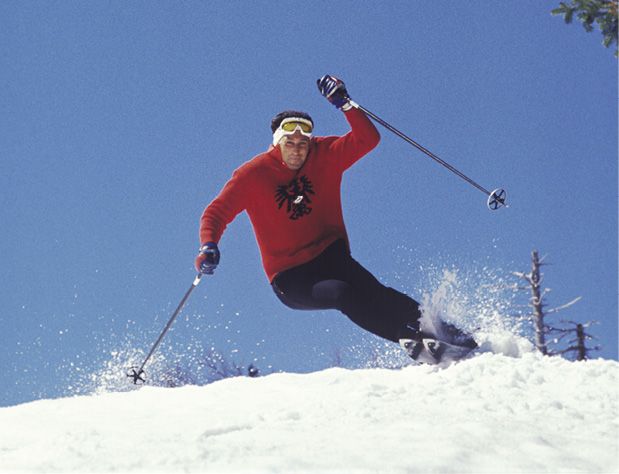
“This one is Emo Henrich, showing how it’s done, around 1973. Of course, you couldn’t get away with locking the feet together all the time. He took some exciting spills on hard snow!”
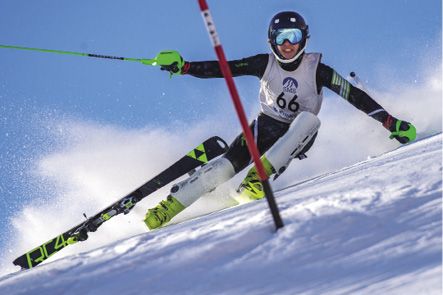
“This is the young Canadian skier Brooks Read, overpowering his own gear in 2019.”
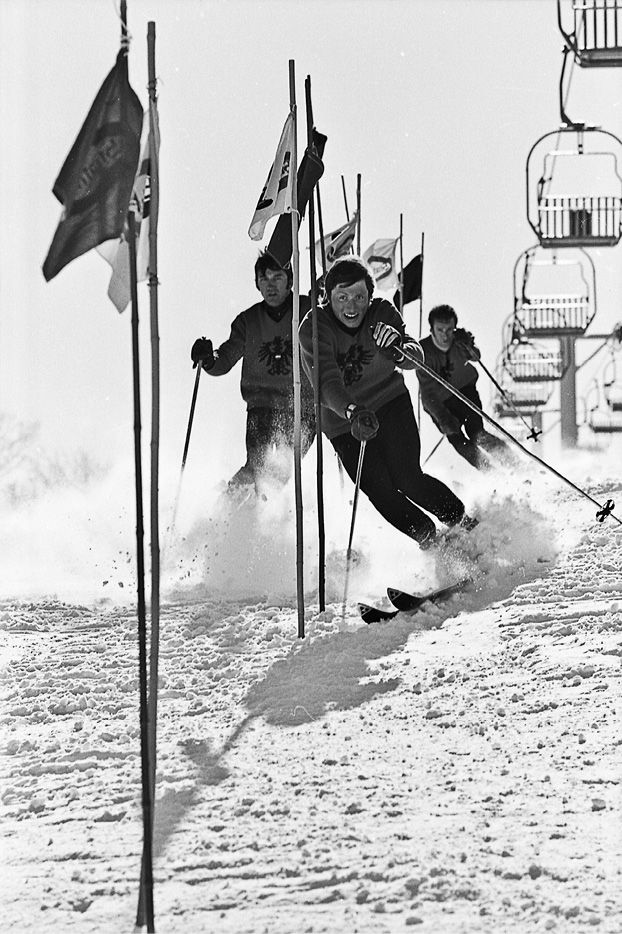
“The skiers are Alfred Trinker, Karl Gegenschatz and Hansi Brantner. This was a set-up. In the early 1970s I didn’t yet have a motor drive, so I needed to get off a single shot. I needed them to ski very clean.”
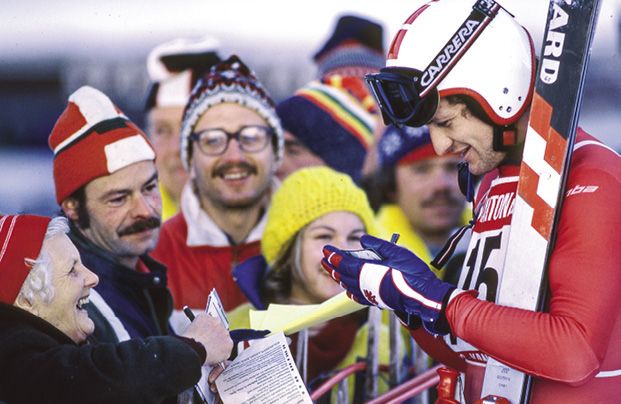
“Franz Klammer greets fans at the St. Anton World Cup in January 1981. He was 27 and would win the World Cup Down- hill title once more, in 1983, before retiring.”
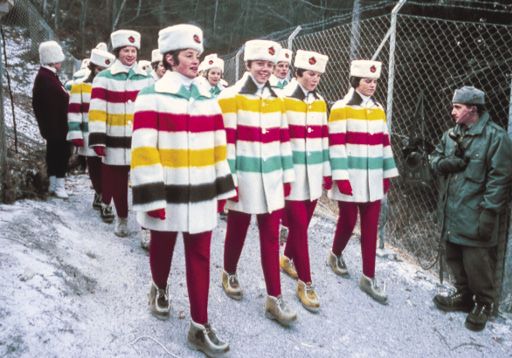
"Here are the Canadian women at the 1964 Olympics in Innsbruck, with 20-year-old Nancy Greene in the middle."

“This is Margaux Hemingway, skiing pow- der in 1981 at Gerlos, near Hintertux. She was a lot of fun to ski with.”
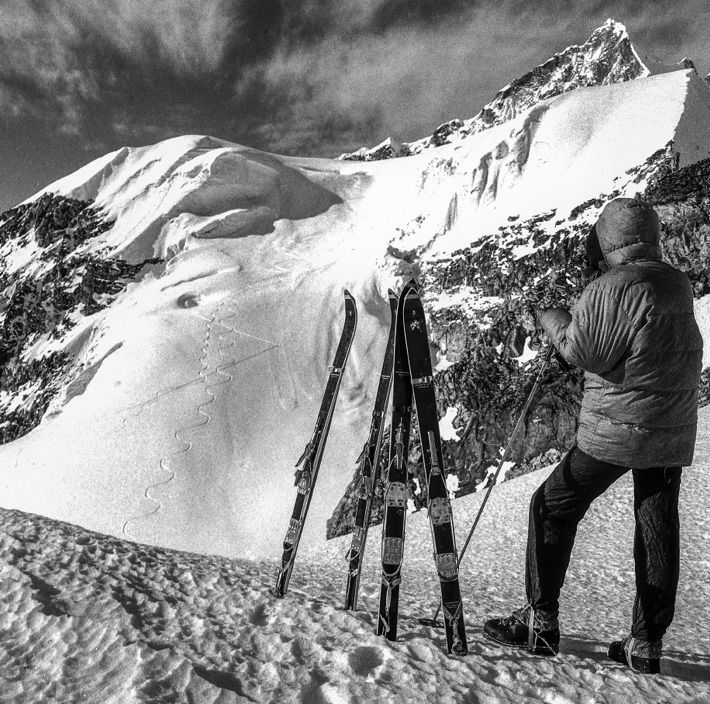
“In 1968, I was in Nepal. We were doing cartography work along the bor- der with Tibet—in fact, this ridgeline on Rolwaling Himal, at 5,900 me- ters near Cho Oyu, forms the border. My partner is Dr. Klaus Göurtler. The evening before we had climbed the opposite side of the valley from our camp at 6,000 meters, and here we are looking at our own tracks.”
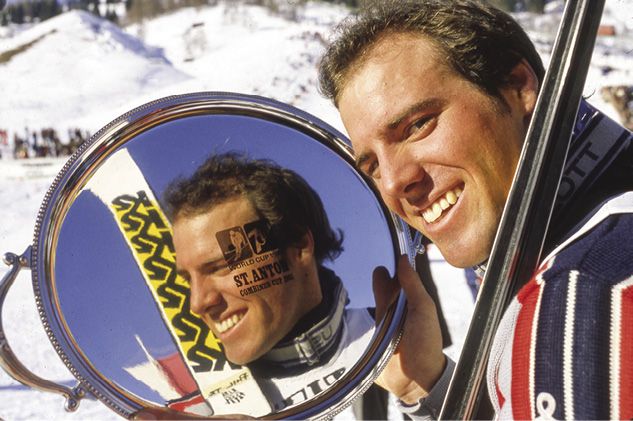
“In 1981, Phil Mahre won his first overall World Cup title, largely based on the combined trophies earned at Morzine, Oberstauffen and, in this photo, at St. Anton. He later beat Stenmark in three technical events [slalom and GS] that season.
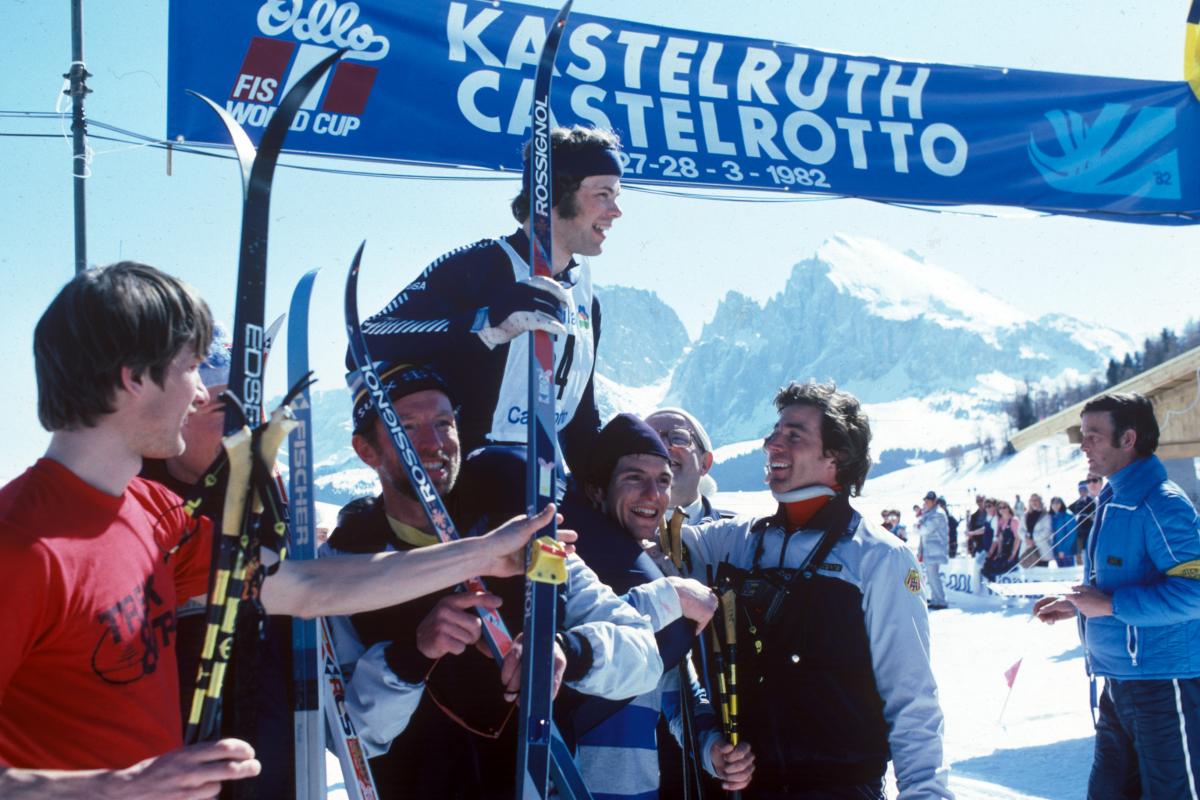
“It seems Phil won almost every time I shot him. At the end of the 1982 World Cup season, I shot him winning the slalom on March 26, in Montge- nèvre, France, wrapping up his second overall World Cup championship. John Fry urged me to get to the Dolomites the next day, where Bill Koch had the chance to win the cross country overall World Cup. So I drove Fry’s car through the night, about 330 miles across northern Italy, and the next morn- ing shot Koch winning the 15k at Castelrotto, and the overall championship.”
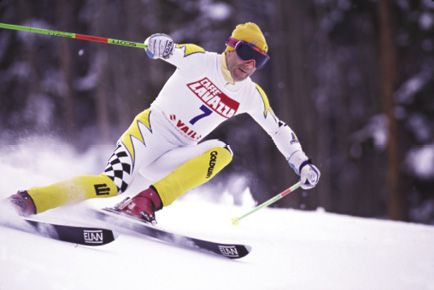
"Ingemar Stenmark at the World championships in Vail, 1989. He would win his last World Cup race, the GS at Aspen, the following week, and retire at the end of the season."
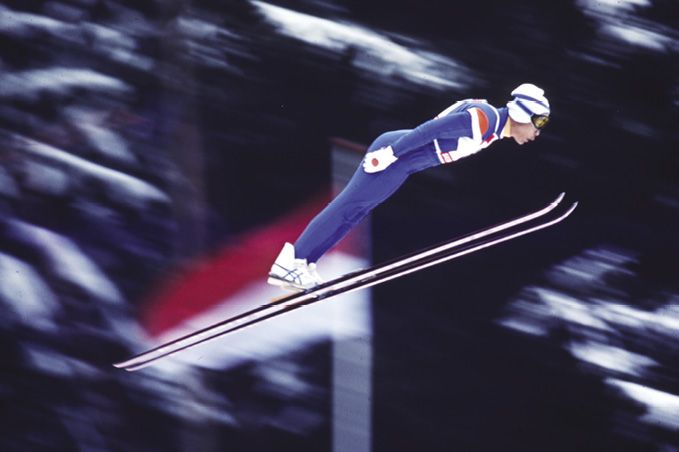
“At the 1976 Olympics, the ski jumps were held at Patscherköpfl. I had not much experience shooting jumping. I learned a bit about panning and got lucky with this shot.”
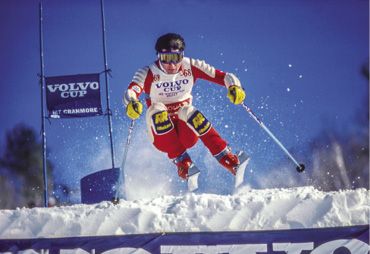
“Today, Andre Arnold is something of a for- gotten name, but he dominated World Pro Skiing, winning the championship in each of its last four seasons—more pro champion- ships than anyone else had ever won.”
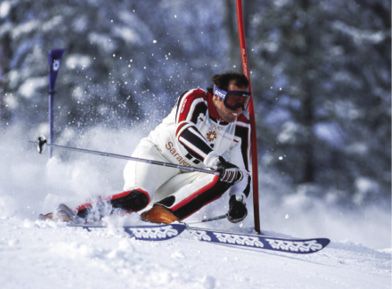
“By 1984, the Mahre brothers were at the top of their game. Here’s Phil in the first run of the Sarajevo Olympic slalom. Steve won that run by .7 sec- onds, but Phil took the second run by more than a second for the gold. The race might have been even more exciting: Stenmark was barred from the Olympics that year for a spon- sorship violation.”
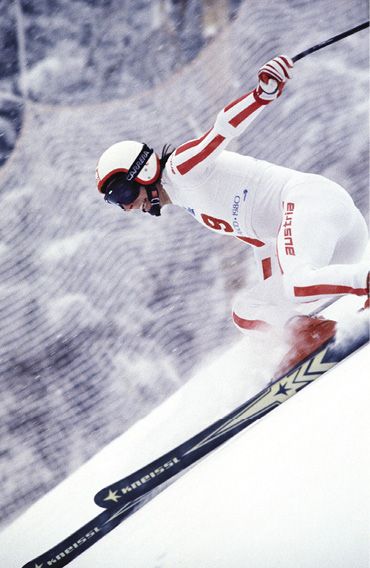
“At the Lake Placid Olympic downhill, in 1980, Leonhard Stock was a last-minute addition to the incredibly deep Austrian squad. The top of the downhill course was cut just for this event, and a temporary poma extended a few hundred feet above the top of Skyward Lift. That’s all gone now. From the top of the poma, I shot off to the left and crawled through the woods to a steep pitch at the big orange safety fence. I had to cut an illegal hole through the mesh and stuck my 300-mm lens
through it. I didn’t have much movement and was so close that each racer just filled the frame—this shot is uncropped. Sports Illustrated had a small army of photog- raphers there and their own lab. They asked if they could process my film and look at it. The next morning I was told, ‘Great shot, Hubert!’ It was the only shot they published, either of Stock or the downhill.”
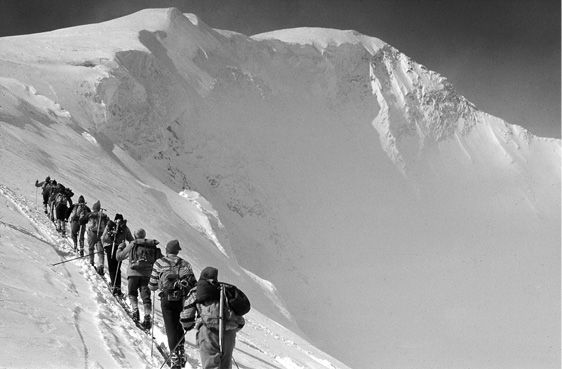
“It was 1959, and I was earning my mountain guide certification in Austria.”
Table of Contents
WORLD CHAMPIONSHIP ($3,000+)
BerkshireEast/Catamount Mountain Resorts
Gorsuch
Warren and Laurie Miller
Sport Obermeyer
Polartec
CHAMPIONSHIP ($2,000)
Fairbank Group: Bromley, Cranmore, Jiminy Peak
Hickory & Tweed
Rossignol
Snowsports Merchandising Corporation
WORLD CUP ($1,000)
Aspen Skiing Company
Atomic USA
Bogner of America
Boyne Resorts
Dale of Norway
Darn Tough Vermont
Dynastar/Lange/Look
Gordini USA Inc/Kombi LTD
Head Wintersports
Intuition Sports
Mammoth Mountain
Marker/Völkl USA
National Ski Areas Association
North Carolina Ski Areas Association
Outdoor Retailer
Ski Area Management
Ski Country Sports
Sports Specialists Ltd
Sugar Mountain Resort
Sun Valley Resort
Vintage Ski World
World Cup Supply
GOLD MEDAL ($700)
Larson's Ski & Sports
Race Place/Beast Tuning Tools
The Ski Company (Rochester NY)
Thule
SILVER MEDAL ($500)
Alta Ski Area
Boden Architecture PLLC
Dalbello Sports
Deer Valley
EcoSign Mountain Resort Planners
Elan
Fera International
Holiday Valley Resort
Hotronic USA/Wintersteiger
Kulkea
Leki
Masterfit Enterprises
McWhorter Driscoll LLC
Metropolitan New York Ski Council
Mt. Bachelor
New Jersey Ski & Snowboard Council
Nils
Russell Mace Vacation Homes
SchoellerTextil
Scott Sports
Seirus Innovations
SeniorsSkiing.com
Ski Utah
Snowbird Ski & Summer Resort
Steamboat Ski & Resort Corp
Sundance Mountain Resort
Swiss Academic Ski Club
Tecnica Group USA
Timberline Lodge and Ski Area
Trapp Family Lodge
Wendolyn Holland
Western Winter Sports Reps Association
World Pro Ski Tour

